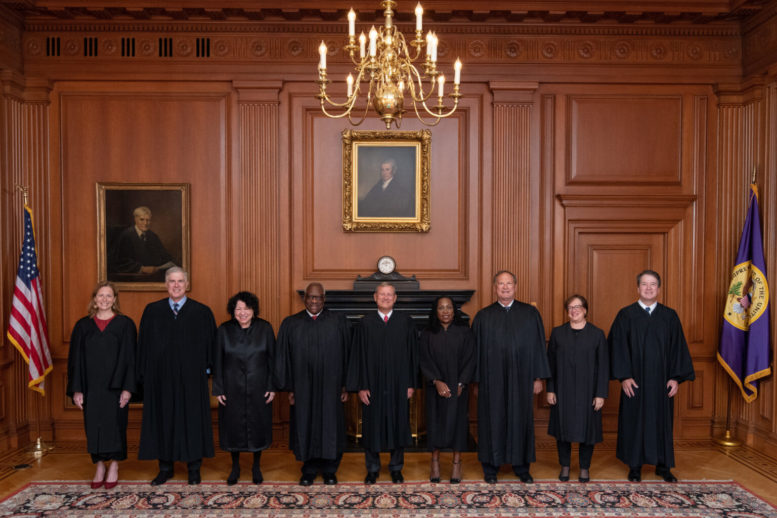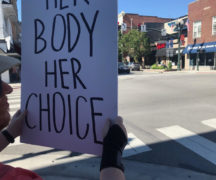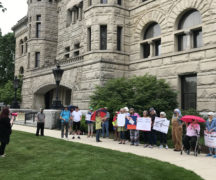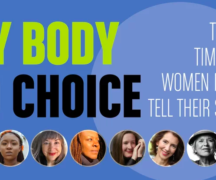When the U.S. Supreme Court in June overturned abortion protections in Roe v Wade, the majority wrote that it’s up to the states to decide whether to allow abortions, restrict them or to ban them altogether. In other words, the six justices were saying that the U.S. Constitution gives no more protections to people who can get pregnant than it does to a zygote, the cell that’s formed when a human sperm fuses with a human egg.
The 76-page opinion, written by Justice Samuel Alito, delves deeply into what he sees as the flaws in the Roe decision and subsequent rulings upholding its central tenet: that at least some right to abortion is inviolable. It also talks a lot about what the abortion laws were around the time the 14th Amendment was ratified in 1868 — and it gives other examples stretching all the way back to the 1200s. And it criticizes Roe for ignoring “the legitimacy of the States’ interest in protecting fetal life.”
But while surveyed history and made nuanced arguments about settled law, the opinion spent almost no time talking about the role abortion plays in 21st-century medicine, or whether the Constitution protects women’s right to avail themselves of that care. By mostly ignoring abortion as healthcare, the conservative justices seemed in important ways to do more to protect a fetus than the life and health of the person carrying it.
History and theory
Much of the legal argument over abortion revolves around whether one is entitled to it in at least some circumstances under the Equal Protection Clause — the part of the 14th Amendment that says the government can’t “deprive any person of life, liberty, or property, without due process of law; nor deny to any person within its jurisdiction the equal protection of the laws.”
The amendment was ratified in the wake of the Civil War in large part to ensure that newly freed slaves would be recognized as citizens and that state governments would respect their rights. But the Supreme Court has subsequently interpreted it to protect other groups who had been treated as inferiors, including women.
However, even though one has to have a uterus to get pregnant, the conservative majority in Dobbs said “a State’s regulation of abortion is not a sex-based classification.”
In making that argument, Alito leaned on two precedents: one that said the Equal Protection Clause did not require that normal pregnancies be covered by the California disability insurance system; and another saying that protestors at Washington, D.C.-area abortion clinics weren’t engaged in class-based discrimination by blocking access; they were expressing their opposition to abortion.
So in Dobbs, the court’s conservatives used two limited precedents to argue that denying women and girls abortions doesn’t discriminate against them as a class. And it in interpreting the original intent of the 14th Amendment, it placed heavy emphasis on abortion laws in the mid-19th century, a time when women had few rights as individuals and medical science was exceedingly primitive by modern standards.
But in the real world after June 24, 2022 — the day Dobbs was handed down — examples of illness and suffering as a consequence of the decision quickly piled up.
A harsh dose of reality
Within hours of the Dobbs decision, Ohio Attorney General Dave Yost got the courts to lift a stay on enforcement of Senate Bill 23. That’s a 2019 law signed by Gov. Mike DeWine that outlawed abortions after about five or six weeks of pregnancy, a point at which about a third of women don’t yet know they’re pregnant.
The law makes no exceptions for rape and incest, and the exceptions it makes for the life and health of the mother are too vague to be workable, say doctors who can lose their licenses and be charged with felonies if they run afoul of it.
A judge in Cincinnati temporarily stopped enforcement of SB 23 on Sept. 14. But just limited examples over 11 weeks of enforcement in a single state show strict laws such as Ohio’s can have profound medical and emotional implications for women and even young girls:
- Just a week after enforcement of SB 23 began came news that a 10-year-old rape victim had to travel from Columbus to Indianapolis for an abortion. Sworn affidavits filed by doctors and other workers in Ohio abortion clinics indicate that at least two more minors who had been raped were forced to leave Ohio to avoid having their rapists’ babies.
- The same affidavits reported on two cancer patients who couldn’t get abortions needed to start chemotherapy.
- They reported on three more women whose pregnancies caused them to vomit incessantly. One was a 16-year-old who had lost 20 pounds. Another was so sick she couldn’t get off of the clinic floor. A mother of four with a responsible job, that woman wondered how she could leave the state in that condition, or keep her job without an abortion.
- Three examples were of women whose fetuses had severe abnormalities or other conditions that made a successful pregnancy impossible. Under the Ohio law, they had to carry those fetuses for months despite the greater risk that posed to their health and the needless emotional suffering it imposed.
- Three women threatened suicide and another said she would try to end her pregnancy by drinking bleach when they learned they couldn’t get abortions, the affidavits said. And throughout the documents were accounts of panicked, despairing women and girls who cried inconsolably when they learned an Ohio abortion wasn’t an option.
DeWine and Yost have mostly avoided talking about those harms publicly, but they’re back in court, trying to reimpose the restrictions that caused them.
Following its own arguments?
When it comes to the lives and health of women and girls, the majority decision in Dobbs in some instances doesn’t seem to be consistent with its own arguments.
For example, in arguing that there were widespread abortion bans in 1868 when the 14th Amendment was ratified, the conservative majority acknowledged that those bans weren’t absolute.
“First, if the ‘long sweep of history’ imposes any restraint on the recognition of unenumerated rights, then Roe was surely wrong, since abortion was never allowed (except to save the life of the mother) in a majority of States for over 100 years before that decision was handed down,” the Dobbs decision says.
But the Dobbs ruling gives no protections to the life of the mother even as it acknowledges, parenthetically, that such protections have long existed. It says simply:
“Abortion presents a profound moral question. The Constitution does not prohibit the citizens of each State from regulating or prohibiting abortion.”
Under Dobbs, in other words, state legislatures can ban abortion altogether or give only the weakest, most ineffective protections of women’s health — even if they’re less than what laws provided between 1868 and 1973, when Roe was decided.
In addition, Alito’s opinion acknowledges the right “to live” as “the most basic human right” while paying almost no attention to the idea that by denying access to abortion, states might deny that right to women and girls.
“According to the dissent, the Constitution requires the States to regard a fetus as lacking even the most basic human right — to live — at least until an arbitrary point in a pregnancy has passed,” the majority opinion in Dobbs says. “Nothing in the Constitution or in our Nation’s legal traditions authorizes the Court to adopt that ‘theory of life.’”
In Roe and in the subsequent decision Casey v Planned Parenthood, past Supreme Courts said women were entitled to abortion access under the Equal Protection Clause and they tried to balance those rights against those of their fetuses. In Dobbs, the present court throws out those precedents as fatally flawed and it it doesn’t attempt any of its own protections of women’s lives and health.
By ignoring abortion as healthcare, the majority in Dobbs seems ignore the fact that just being pregnant subjects women to far more danger than does abortion. A study of pregnancies in the United States between 1998 and 2005 found that women were almost 15 times more likely to die from pregnancies than from getting abortions.
Having hypertension or diabetes, or being very young, or relatively old, and myriad other conditions increase pregnancy risks beyond that. And simply being pregnant and Black — the group that gets by far the highest rates of abortion in Ohio — makes a woman three times more likely to die from a pregnancy than her White counterpart, according to the U.S. Centers for Disease Control and Prevention.
And then there are abortions to save women who are literally dying. So far, no state’s abortion law lacks at least some exceptions to protect the life of the mother. But in a dissenting opinion, three Supreme Court justices noted that the Dobbs majority doesn’t require such longstanding protections.
“That women happily undergo those burdens and hazards (of pregnancy) of their own accord does not lessen how far a State impinges on a woman’s body when it compels her to bring a pregnancy to term,” the dissent said. “And for some women, as Roe recognized, abortions are medically necessary to prevent harm. The majority does not say — which is itself ominous — whether a State may prevent a woman from obtaining an abortion when she and her doctor have determined it is a needed medical treatment.”
Ignoring the professionals
As in the 26 states that have or are likely to severely restrict abortion, the majority in the Dobbs decision seemed unmoved by the advice of medical professionals.
The American College of Obstetricians and Gynecologists, the American Medical Association and many other professional groups briefed the Supreme Court in opposition to the Mississippi law at issue in Dobbs. It bans almost all abortions after 15 weeks.
The brief said, “the Ban threatens the health of pregnant patients by arbitrarily barring their access to a safe and essential component of healthcare. In particular, patients of color, those with limited socioeconomic means, and those in rural communities would be most severely harmed should the Ban be allowed to go into effect.”
The friend-of-the-court brief urged the justices to find that pregnant girls and women have a constitutional right under the Equal Protection Clause to the protections modern healthcare can provide.
“The Ban also impermissibly intrudes into the patient-physician relationship by limiting a physician’s ability to provide the healthcare that the patient, in consultation with her physician, decides is best for her health,” it said. “Moreover, the Ban undermines long-standing principles of medical ethics and places clinicians in the untenable position of choosing between providing care consistent with their best medical judgment, scientific evidence, and the clinicians’ ethical obligations or risk losing their medical licenses.”
Ohio’s abortion clinics made similar arguments in their case in Cincinnati, saying that the Ohio constitution protects rights to such healthcare.
In granting a preliminary injunction earlier this week, Hamilton County Common Pleas Judge Christian Jenkins agreed, saying “Abortion is safe healthcare to which Ohioans have a right.” He added, “Ohio’s constitution specifically and unambiguously recognized as fundamental the right to liberty … and the right to seek and obtain safety.”
Whether Jenkins’ ruling stands depends on who is on the Ohio Supreme Court when it hears the case, possibly early next year.
At least one of the three Republican justices who are up for re-election on Nov. 8 has said he can’t take a public position on abortion because the issue is likely to come before them. But News 5 Cleveland reported earlier this month that the three — Sharon Kennedy, Pat DeWine (Gov. DeWine’s son) and Pat Fischer — told Cincinnati Right to Life in candidate surveys that women don’t have a constitutional right to abortion.





